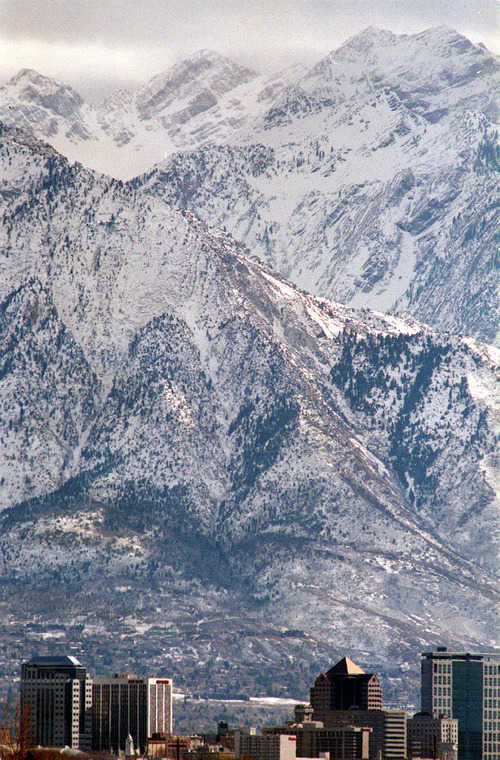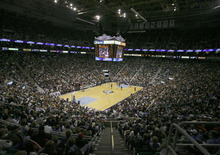This is an archived article that was published on sltrib.com in 2010, and information in the article may be outdated. It is provided only for personal research purposes and may not be reprinted.
Flash forward to August 2012.
The streets of downtown Salt Lake City are choked with buses, limousines and cabs shuttling 45,000 visitors who have descended to anoint their standard-bearer, who by that time has run the gantlet of presidential nominating contests.
Hotel rooms are filled and a four block area around EnergySolutions Arena and the Salt Palace Convention Center have been cordoned off to create a security zone.
Former U.S. presidents, top contenders for the Oval Office, well-known political figures and other VIPs are whisked into restaurants and scores of private parties by their entourages and security details.
About 15,000 reporters watch for any hiccup and, as they did when Utah staged the 2002 Winter Olympics, some inevitably turn their eye to the state's predominant LDS faith.
This is a taste of what Utah's top GOP officials and business leaders are vying for this week as a team of Republican National Committee members —including party Chairman Michael Steele — visits Salt Lake City to review the city's bid to host to the party's highest-profile, highest-stakes gathering: the 2012 national convention.
The economic benefit of hosting the event could be enormous with an estimated $170 million in spending, although some caution the benefits are overblown.
"Anytime you have literally one of the biggest conventions that are put on in America in your city, it's a big deal," said Lane Beattie, president of the Salt Lake Chamber of Commerce and chairman of the host committee. "These conventions, either the Democrats' or Republicans', are just one of the real plums to get into your location."
It won't come cheap.
The RNC requires the host city to foot the bill — an estimated cost of $35 million to $45 million. Typically, businesses and other deep-pocket donors pour money into sponsorships.
The GOP convention would draw about twice as many people as the Outdoor Retailer show and half as many as when the city welcomed the 2002 Winter Olympics, said Scott Beck, president of the Salt Lake Convention and Visitors Bureau.
All of downtown, Beck said, would take on the look and feel of the nominating convention and the GOP brand would be ubiquitous.
Roads would be turned into dedicated arteries to and from the convention site, and throngs of conventiongoers would pour into the surrounding shops, including the City Creek Center development, which is scheduled to be completed in 2012.
Hotels from Ogden to Provo would be near capacity, putting up the tens of thousands of guests, said Michael Johnson, executive director of the Utah Hotel and Lodging Association.
"It's going to fill up a whole lot of rooms at a pretty good rate for the course of a week," Johnson said. "Generally, that is going to be great."
The benefits might not be evenly distributed. Some large downtown hotels expect to be hit up for donations to help pay for part of the convention, Johnson said, and that might mean the room bookings won't translate into a big boost for them.
The ancillary benefits, though, loom large.
"It has a huge impact for us, not only from a monetary standpoint … but it also means there is a great deal of press that follow up. They visit the site, they visit the city," Beattie said. "It's a great source for us to promote our state from a lot of people who visit it and find out a lot more about Utah."
While the convention hall would be packed with delegates, dignitaries and media, Beck said events surrounding that hub would offer opportunities for average Utahns to take part in the experience.
During the 2008 Republican convention, for example, Minnesota's Twin Cities staged CivicFest, which included exhibits featuring a detailed scale model of the White House, a replica of the president's desk, a life-size reproduction of the fuselage of Air Force One, historic flags and dresses of first ladies.
More than 75,000 people toured the exhibit in Minneapolis.
A study by the 2008 host committee concluded the convention pumped nearly $170 million in new spending into the area, added 2,800 jobs, which brought in about $100 million in wages. By the committee's estimates, about 45,000 people flooded the Twin Cities, with the average conventiongoer spending $1,600.
And then there were the not-so-visible benefits.
St. Paul police Sgt. Paul Schnell said the extra training that the city's force received before the convention, as well as extra equipment, such as riot and emergency gear, meant the city gained in the long run.
"There's no doubt you can't have this type of experience and not have some residual benefits of the incredible amounts of training that officers had, some equipment we didn't have before," Schnell said. "Those kinds of infrastructure, assets will serve St. Paul for years to come."
But a 2008 study of national political conventions from 1970 to 2005 determined that the economic promises are exaggerated.
Rob Baumann, an economics professor at Holy Cross College, co-wrote a study that found little, if any, real impact on employment or personal income as a result of hosting the convention.
The figures proponents cite don't account for people who stay away from the city to avoid the convention crowds and tend to understate the costs.
And the benefits are not consistent in all sectors — hotels and restaurants might do well, but retailers don't see a spike and other businesses; an accounting firm, for example, might suffer from the headaches caused by congestion.
But Baumann acknowledges the harder-to-gauge benefits — such as exposure from having the city in the public spotlight.
"What we would prefer is just sort of an honest assessment that this is probably, at best, going to break even," Baumann said. "If you're doing this, don't be doing it with money as the bottom line. Do it for the notoriety and press coverage, which are things that are positive gains but are hard to measure."
The same authors calculated that staging the 2002 Winter Olympics was a net loss for Salt Lake City, but Baumann said it bolstered the city's profile. The Republican convention could do the same.
Some St. Paul business owners say they were stoked for the convention to come, but their hopes for big profits didn't come through.
Mancini's Char House, one of the city's premier steakhouses, ramped up staffing and prepared for several big parties for the 2008 convention. But security measures along with events and hotels scattered throughout the Twin Cities meant conventiongoers spent more time busing from locale to locale and little time walking the city.
Hurricane Rita in the Gulf of Mexico kept the first days of the convention low key and prompted several parties to cancel.
"As far as I'm concerned, I don't think any of them even saw St. Paul," said owner Pat Mancini. Near his restaurant, "it was like Guantanamo Bay. There was like a 10-foot perimeter fence around the arena; Humvees loaded with machine guns. Obviously, my regular customers weren't even coming near."
Eagle Street Grille, the closest bar to the Xcel Energy Center, became the CNN grill for the convention and found itself inside the outer security perimeter where only pass-holders could enter. Kevin Geifen, one of the bar's co-owners, said he figured his bar would do very well, but was disappointed.
"St. Paul basically became a huge cage," Geifen said, "people were bused in, they got out, they got back in and left.
"For the city as a whole, it was a positive impact," he added. But "there was no one business owner that made out like a bandit. If any one was going to get that, it was us, and I'll tell ya we didn't."
Ryan Kelly, who organized several events surrounding the convention, said there may have been some overinflated expectations of what a direct boon the convention would bring but that still were some great long-term benefits.
"From a regional perspective, there's just an intrinsic value of hosting something of that size on a national stage, in addition to what economic benefit you'll see," Kelly said. "There's something that just can't be measured in dollars and cents in putting St. Paul and Minneapolis on a stage like that."
Whether Salt Lake City finds itself on that same stage will be known later this year. The Republican National Committee will decide the convention site at its quarterly meeting this summer.
Showing off Salt Lake City
The visiting team from the Republican National Committee will be greeted with a dinner Monday night (attendees will include Salt Lake City Democratic Mayor Ralph Becker).
Area business leaders attending the dinner have been asked to contribute to help raise the $50,000 needed to host the bid-review panel.
On Tuesday, the RNC Site Selection Committee will visit Utah Olympic Park near Park City and Salt Lake City's LDS Temple Square before attending a Utah Jazz game at EnergySolutions Arena, a focal point for the gathering.
On Wednesday, they will receive a full tour of the arena and the nearby Calvin L. Rampton Salt Palace Convention Center.
"We're really focusing on those things that are intrinsically Utah," says Salt Lake Convention and Visitors Bureau President Scott Beck — from the mountains and Temple Square the guests will view to the Utah-produced food they will eat.
Hosts will sort of act as Sherpas to help visitors navigate the city and — borrowing from the Olympic experience — collectable pin-trading will be used to engage delegates and put a local stamp on the event.
There is no specific plan to show the Republican guests the area's night life — or more specifically that visitors can, in fact, get a drink in the city, a question Beck says came up when the bid team presented to the RNC in Washington, D.C., in February.
It is a common question, Beck says, from prospective conventiongoers. "We know from a lot of experience that the best way to [deal with] it is just let it happen organically." Beck says the delegation will see firsthand that people can order drinks in a hotel or a bar and it's not much different than the other competitors.







